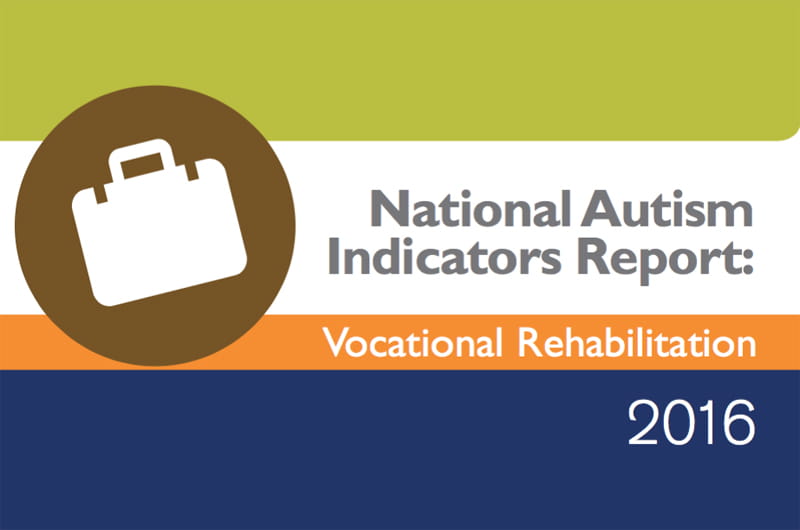Drexel’s National Autism Indicators Report: More Than Half Leave Vocational Rehabilitation with Jobs, But Most Earn Wages Below Poverty Line
 By Frank Otto
By Frank Otto

- Drexel Environmental Collaboratory Releases Cross-Sector Findings on Severe Weather Recovery Challenges
- Drexel’s Hydration Stations Cut Plastic Waste and Costs
- Drexel Launches the Manuel Stamatakis Center for Alternative Investments at the LeBow College of Business
- Faculty Highlights: Recent Awards and Grants

The A.J. Drexel Autism Institute’s latest National Autism Indicators Report found that 60 percent of people with autism who received services from Vocational Rehabilitation left the program with jobs, but a majority earned wages below the federal poverty line.
Last year’s National Autism Indicators Report found that a third of young adults never got work or continued education between high school and their early 20s. Exploring that issue, the 2016 report specifically examined the U.S. Vocational Rehabilitation system, which is the nation’s largest source of public assistance for people with disabilities who seek employment.
“Unemployment is a critical issue facing people on the spectrum who have valuable contributions to make but not enough opportunities to have work,” said Paul Shattuck, PhD, leader of the Life Course Outcomes Research Program in the Institute, which produces the National Autism Indicators Report series. “Anything we can do to understand the support systems that are in place to secure employment for adults with autism will enable us to better assist this population in the future.”
Vocational Rehabilitation is a federally funded program that is administered under the U.S. Department of Education through the states. Its goal is to assist people with disabilities to get and keep jobs. In doing so, it collects data about its services — such as on-the-job supports and job placement — and the outcomes in each state.
Looking at that data, Drexel’s researchers found that the number of people with autism who applied to Vocational Rehabilitation more than doubled between 2009 and 2014, going from 7,428 to 17,753. Of those who were eligible, 68 percent received services.
Ultimately, roughly 60 percent of people with autism had a job when they left the program. Most of those jobs fell into six categories, with office and administrative support being the most common, followed by food preparation/serving and building/grounds cleaning and maintenance.
Jobs held by those when they left the program followed national labor market needs and were in areas with the most projected growth for the next decade.
“We found that over half of the people with autism who used Vocational Rehabilitation services got jobs,” said Anne Roux, lead author of the report and research scientist in Life Course Outcomes at the institute. “While it was the same rate as people with other types of disabilities who used the program, the wages, hours worked and range of job types for people with autism were low — placing them at risk for poverty.”
More than 80 percent of people with autism who left Vocational Rehabilitation with a job worked part time — compared to 19 percent of the general population.
Those who left the program with a part-time job had median weekly earnings of $160. When looking at the federal poverty guidelines for 2014 (the year the salary data was gathered), those with autism who worked part-time earned wages that were below the poverty line — which stood at roughly $224 per week.
The 20 percent of those with autism who left Vocational Rehabilitation with a full-time job earned a median weekly wage of $380.
“Where you live matters,” when it comes to Vocational Rehabilitation, according to the report. Differing policies, legislation and economic elements in each state present unique factors, and the implementation of new federal legislation, the Workforce Innovation and Opportunity Act (WIOA), will likely provide more variation.
This year’s report looked in-depth at the numbers by state and found differences.
- The rate of employment upon leaving Vocational Rehabilitation was highest in Alabama (79 percent) and lowest in New Mexico (29 percent)
- Median hourly wages for those with autism who received Vocational Rehabilitation services were compared to workers in each state: Washington D.C. had the highest disparity at $22.95; West Virginia had the lowest at $4.04
The Life Course Outcomes Research Program’s mission is to build a base of knowledge about topics, other than clinical interventions, that promote positive outcomes for people on the autism spectrum, their families and communities. As such, this year’s report on employment will provide another critical step forward in expanding the conversation about what we know — and what we need to know — to improve the quality of life for adults with autism.
“We envision a future in which people on the autism spectrum are valued as contributing members of communities, with roles to play and dreams to pursue,” Roux said. “Each step we take with our research builds knowledge that brings us closer to that goal.”
The full report can be viewed through this link.
Drexel News is produced by
University Marketing and Communications.